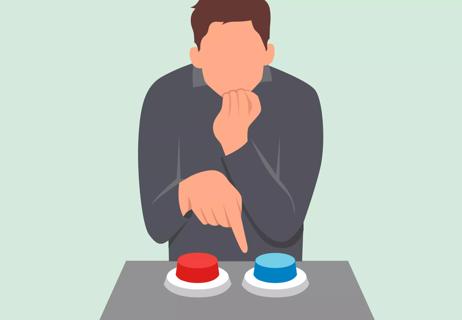Learn how a little quiet time can make a big difference

Kids are always on the move. And with all of the hustle and bustle, they could use some time to unplug and reset. If you’re looking for a way to help your child chill out, meditation might be the thing. So, how do you get started if you don’t have a little yogi or flower child on your hands? Pediatrician Matthew Badgett, MD, outlines the benefits of meditation for children and shares tips for how to get your child started.
Advertisement
Cleveland Clinic is a non-profit academic medical center. Advertising on our site helps support our mission. We do not endorse non-Cleveland Clinic products or services. Policy
While a great deal of research has been done to examine the effects of meditation, most of it has involved adults. In these cases, Dr. Badgett says the studies show that meditation can help ease anxiety, depression and insomnia. It can also improve mood and focus.
And while not as much research has been done about how meditation affects kids, what has been done is quite positive. In one trial, school-based mindfulness instruction led to improved psychological functioning and lower levels of post-traumatic stress disorder (PTSD) symptoms for a group of 300 middle school students. Another trial showed regular meditation sessions can help lower a child’s blood pressure and heart rate.
“When we have electronics that are made to catch our attention and then rotate our attention quickly through multiple things, it can be really hard for us to remain calm and comfortable,” says Dr. Badgett. “This can be even tougher for kids. Meditation can be beneficial because it allows us to teach our kids a system that allows them to move more methodically and a little bit more carefully through their thoughts — and through the world.”
He adds that meditation helps children be less reactive to their emotions and things that are going on around them.
Advertisement
“They will be able to react less and observe more. That matters because when kids have better control of their emotions, they can focus more in school and pay attention during conversations rather than being very distracted by everything that is going on inside them.”
Kids can benefit from meditation at any age. However, it’s important to adjust the form based on how old they are. For instance, if you struggle to make it through a five-minute seated meditation session, don’t expect your little one to cruise through it.
“A lot of preschools nowadays have newborns doing yoga or kids might have music time where they watch someone play an instrument. Focusing on activities like these can provide meditative benefits,” notes Dr. Badgett.
So, you don’t sit cross-legged in a candlelit room with your eyes closed with pan flute music softly playing in the background regularly. And your affirmations might be full of four-letter words instead of peaceful phrases. Does that mean that you can’t meditate or teach your kids how to meditate? Not at all. Here’s one thing to remember as you get started: There’s no specific way to meditate, and it can just be an activity that’ll hold your child’s attention. The key is to make sure it slows them down and allows them to focus.
“Meditation is like an open-ended statement — there are a lot of different forms,” says Dr. Badgett. “And with kids, we really need to be open-ended, too. This means not necessarily engaging in the strictest forms of meditation like sitting still or focusing on the breath. In the beginning, it might just be quiet time or going on a walk every day. These are ways to provide the basic concepts of meditation to kids as they develop.”
If you need some inspiration, Dr. Badgett suggests checking out a few meditation apps or even YouTube. Many of these outlets have meditations or stories for children that’ll work when you want your child to relax and unwind.
You’ve called your child into the living room, they’re sitting down and you ask them to take some deep breaths while listening to nature sounds. One minute in and they’re squirmier than a worm on the sidewalk during a rainy day. That’s one indication that your meditation sessions might need to be shorter or more kid-friendly. Explains Dr. Badgett:
“If you ask your child to sit down for five minutes to breathe slowly and they make it 30 seconds, then that might be too much for them. Now, if you ask them to focus for five minutes and they get a little squirmy after 90 seconds, help them to re-focus and allow them to get comfortable again. If they are good for another 90 seconds, keep going. You might do this a few times and stop once you get close to five minutes and that is good.”
While the length of meditation all comes down to how engaged or interested your child is, here are some suggested meditation times from the American Academy of Pediatrics:
Advertisement
Picking up a new habit is never easy, but your child can do it. But if you notice they only last a very short time, become irritable or upset, or panic when you ask them to focus on their breath, you’ll know that your child is feeling more stress than Zen. If trying to meditate is consistently upsetting, talk to your child’s healthcare provider about alternatives.
Meditation for kids can take on many forms. Dr. Badgett says you can try movement-based activities like yoga, swimming or walking. Movement-based “meditation” requires a lot of thought and focus because kids have to pay attention to what they’re doing. However, team sports don’t fall into that category because they can get a little too chaotic.
If you want to do something that involves less movement and even more concentration, you can read a book together. Don’t rush through the story (even if it’s the millionth time you’ve read it to your child). Take your time, ask questions about the book and let your child describe the pictures. Slow the experience down and allow your child to take it all in.
Other forms of meditation include:
Advertisement
“Get your child to focus on something a little bit more kinetic and not as flashy. Have them play a basic instrument like a drum. The activity can be relatively repetitive but engaging. But anything that can get their mind off of distractions and electronics for an extended period is going to have meditative benefits,” says Dr. Badgett.
Children’s meditation techniques might be a little more stripped down than those of adults, but Dr. Badgett says the whole family can still benefit from them. And by meditating together, your family can become much closer:
“Simple meditation techniques for the kids are always going to benefit the parents. If you find something that they can do, and you do it as well, you all will gain so much from this family bonding time. Even though you might be able to handle something more complex and structured, you can still benefit from these simple activities that your child is doing. Making meditation a daily family activity, or is going to be quite powerful for all individuals in that unit.”
Advertisement
Learn more about our editorial process.
Advertisement

You don’t need to have years of experience to reap the rewards of meditation — with benefits for your whole body, you only need a couple minutes to get started

While walking, be mindful of your body, your mind, your place in the world and all five of your senses as you pave a path forward, one step at a time

Enter relaxation mode by managing your breathing, releasing muscle tension and practicing mindfulness

Thunder, waterfalls and heavy rain — these low-frequency sounds might help cancel out disruptive noises and thoughts

Immersing yourself in nature can improve both your mental and physical health

Don’t let the fear of making the ‘wrong’ decision stop you from moving forward

This bedtime exercise can help you fall asleep faster (and stay asleep)

Use this technique to increase awareness of your body and assess how you’re feeling

If you’re feeling short of breath, sleep can be tough — propping yourself up or sleeping on your side may help

If you fear the unknown or find yourself needing reassurance often, you may identify with this attachment style

If you’re looking to boost your gut health, it’s better to get fiber from whole foods